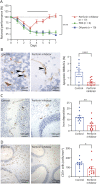Effects of a Small-Molecule Perforin Inhibitor in a Mouse Model of CD8 T Cell-Mediated Neuroinflammation
- PMID: 37080596
- PMCID: PMC10119812
- DOI: 10.1212/NXI.0000000000200117
Effects of a Small-Molecule Perforin Inhibitor in a Mouse Model of CD8 T Cell-Mediated Neuroinflammation
Abstract
Background and objectives: Alteration of the blood-brain barrier (BBB) at the interface between blood and CNS parenchyma is prominent in most neuroinflammatory diseases. In several neurologic diseases, including cerebral malaria and Susac syndrome, a CD8 T cell-mediated targeting of endothelial cells of the BBB (BBB-ECs) has been implicated in pathogenesis.
Methods: In this study, we used an experimental mouse model to evaluate the ability of a small-molecule perforin inhibitor to prevent neuroinflammation resulting from cytotoxic CD8 T cell-mediated damage of BBB-ECs.
Results: Using an in vitro coculture system, we first identified perforin as an essential molecule for killing of BBB-ECs by CD8 T cells. We then found that short-term pharmacologic inhibition of perforin commencing after disease onset restored motor function and inhibited the neuropathology. Perforin inhibition resulted in preserved BBB-EC viability, maintenance of the BBB, and reduced CD8 T-cell accumulation in the brain and retina.
Discussion: Therefore, perforin-dependent cytotoxicity plays a key role in the death of BBB-ECs inflicted by autoreactive CD8 T cells in a preclinical model and potentially represents a therapeutic target for CD8 T cell-mediated neuroinflammatory diseases, such as cerebral malaria and Susac syndrome.
Written work prepared by employees of the Federal Government as part of their official duties is, under the U.S. Copyright Act, a “work of the United States Government” for which copyright protection under Title 17 of the United States Code is not available. As such, copyright does not extend to the contributions of employees of the Federal Government.
Conflict of interest statement
C. Fonte, E. Dufourd, V. Cazaentre, S. Aydin, B. Engelhardt, R. R. Caspi, B. Xu, G. Martin-Blondel, J.A. Spicer, and C. Bost report no disclosures relevant to the manuscript. C. Gonzalez-Fierro reports financial support by Fondation pour la Recherche Médicale (FRM). R.S. Liblau reports financial support by Fondation pour la Recherche Médicale (FRM), the French MS society (ARSEP foundation), Agence Nationale pour la Recherche CE17-0014, and BETPSY RHU 18- RHUS-0012. J. Bauer reports financial support by Austrian Science Fund FWF: P34864-B. J.A. Trapani reports financial support by the Strategic Drug Discovery Initiative (SDDI) Program of the Wellcome Trust UK. Go to
Figures





Similar articles
-
Perforin Expression by CD8 T Cells Is Sufficient To Cause Fatal Brain Edema during Experimental Cerebral Malaria.Infect Immun. 2017 Apr 21;85(5):e00985-16. doi: 10.1128/IAI.00985-16. Print 2017 May. Infect Immun. 2017. PMID: 28264905 Free PMC article.
-
Induction of blood brain barrier tight junction protein alterations by CD8 T cells.PLoS One. 2008 Aug 22;3(8):e3037. doi: 10.1371/journal.pone.0003037. PLoS One. 2008. PMID: 18725947 Free PMC article.
-
Modulatory effects of perforin gene dosage on pathogen-associated blood-brain barrier (BBB) disruption.J Neuroinflammation. 2016 Aug 31;13(1):222. doi: 10.1186/s12974-016-0673-9. J Neuroinflammation. 2016. PMID: 27576583 Free PMC article.
-
Structural pathways for macromolecular and cellular transport across the blood-brain barrier during inflammatory conditions. Review.Histol Histopathol. 2004 Apr;19(2):535-64. doi: 10.14670/HH-19.535. Histol Histopathol. 2004. PMID: 15024715 Review.
-
Cerebral malaria pathogenesis: Dissecting the role of CD4+ and CD8+ T-cells as major effectors in disease pathology.Int Rev Immunol. 2024;43(5):309-325. doi: 10.1080/08830185.2024.2336539. Epub 2024 Apr 15. Int Rev Immunol. 2024. PMID: 38618863 Review.
Cited by
-
Perceiving traumatic brain injury from glymphatic system.Mol Psychiatry. 2025 Jul 31. doi: 10.1038/s41380-025-03126-6. Online ahead of print. Mol Psychiatry. 2025. PMID: 40745390 Review.
-
Endothelial cells and macrophages as allies in the healthy and diseased brain.Acta Neuropathol. 2024 Feb 12;147(1):38. doi: 10.1007/s00401-024-02695-0. Acta Neuropathol. 2024. PMID: 38347307 Free PMC article. Review.
-
Greater mechanistic understanding of the cutaneous pathogenesis of Stevens-Johnson syndrome/toxic epidermal necrolysis can shed light on novel therapeutic strategies: a comprehensive review.Curr Opin Allergy Clin Immunol. 2024 Aug 1;24(4):218-227. doi: 10.1097/ACI.0000000000000993. Epub 2024 May 17. Curr Opin Allergy Clin Immunol. 2024. PMID: 38753537 Free PMC article. Review.
-
The Interplay between Ferroptosis and Neuroinflammation in Central Neurological Disorders.Antioxidants (Basel). 2024 Mar 26;13(4):395. doi: 10.3390/antiox13040395. Antioxidants (Basel). 2024. PMID: 38671843 Free PMC article. Review.
-
Pharmacologic inhibition of dipeptidyl peptidase 1 (cathepsin C) does not block in vitro granzyme-mediated target cell killing by CD8 T or NK cells.Front Pharmacol. 2024 Jul 3;15:1396710. doi: 10.3389/fphar.2024.1396710. eCollection 2024. Front Pharmacol. 2024. PMID: 39021839 Free PMC article.
References
Publication types
MeSH terms
Substances
Grants and funding
LinkOut - more resources
Full Text Sources
Research Materials
